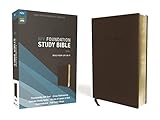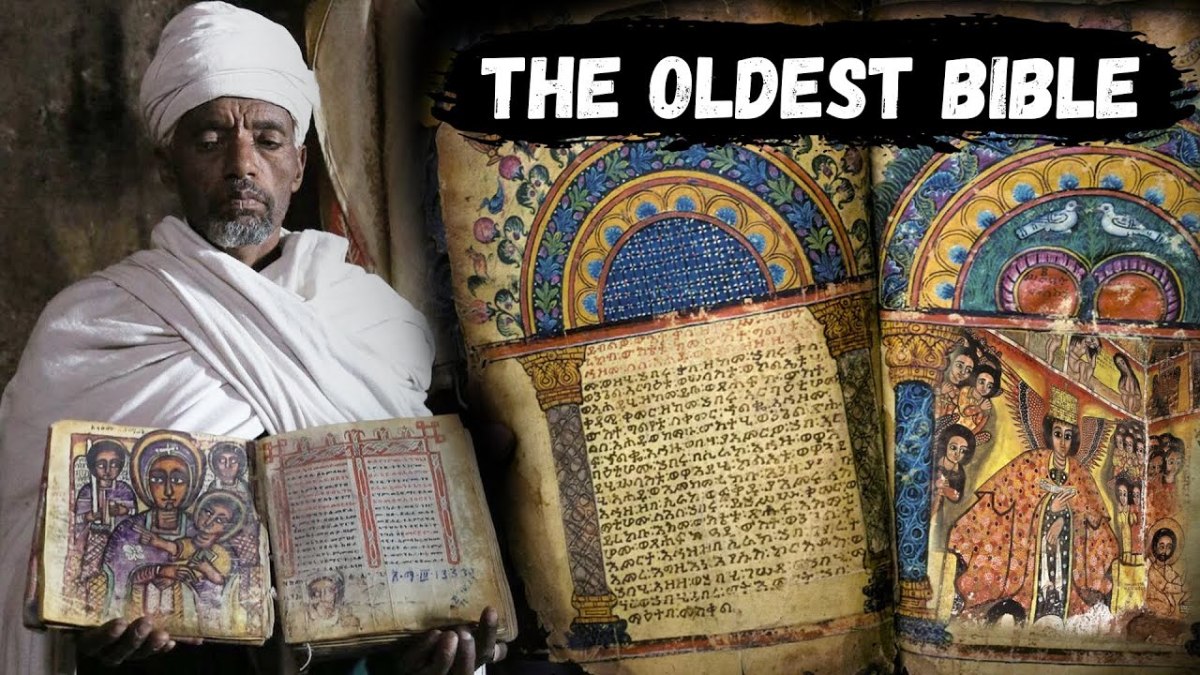How to use Bible study tools


Introduction
The Bible is the most fascinating book ever written. With sixty-six books written in three different languages by 40 different men and penned over 1500 years, it is amazing how perfectly it all fits together. It is a book of hope, salvation, wisdom, truth, history, science, miracles, humanity, Deity and life changing power. It is the Word of God. Its meaning confounds the wise, but understanding can be found by children. It is both simple and complex. We are privileged to read it and we have the choice to believe it. With layer after layer of meaning and application, anyone who is willing, can learn from it and find understanding no matter how simple minded or wise.
The key to understanding the Bible is a heart that is willing to listen to the Holy Spirit. God loves us and wants us to be able to understand the truth he has for us. Therefore He gave us the Holy Spirit. Jesus spent three years of his life here on earth teaching us about God and his kingdom. Before he went back to heaven he promised “The counselor, the Holy Spirit, whom the Father will send in my name, will teach you all things and will remind you of everything I have said to you.-John 14:26. Whenever we sit down to study the Bible, we are reading the words of God. It is a good practice to begin with prayer. Prayer is simply talking to God. We can humbly ask him to show us the truth. He promises “Then you will call upon me and come and pray to me, and I will listen to you. You will seek me and find me when you seek me with all your heart.”- Jeremiah 29:12, 13. God knows our hearts and the motivations behind everything we do. If we are not open to what the Bible has to say, it is possible we will never be able to understand it.
Even with an open heart, many are still confused about the meaning of the Bible. We hear others tell us that it is full of contradictions and unreliable. Religious people argue about the things it says and churches split over differing opinions on how to apply it properly. Even pastors and priests will sometimes discourage us from reading the Bible to find out the truth for ourselves. So how is the average, normal person supposed to find the meaning in the Bible that will change their lives? This article is intended to share important tips help you when you are reading the Bible. It also has an overview of several different tools that are helpful in the search for meaning in the scriptures. Tools such as specialty Bibles, Concordances and Dictionaries along with a look at the importance of keeping the Bible in context and things to keep in mind while researching are included. They can be a guide to you in your own search for truth.

The importance of Context
Tip #1 -Keep the Bible in Context
Tool #1 – Your Brain and a Bible
The first thing to remember is Context. Every word of the bible is absolutely true in its context. This is important because you can prove just about anything with words from the Bible when they are taken out of their proper environment. This can be a very dangerous thing. Consider the man who was under pressure to make a life changing decision. For days he struggled, unable to decide what to do. Finally, on the advice of a friend, he went to the bible for direction. Not knowing where to start, he closed his eyes, opened his Bible and put his finger on the page. Opening his eyes, he read Matthew 27: 5 “So Judas threw the money into the temple and left. Then he went away and hanged himself.” Alarmed, he thought to himself, “that surely can’t be right” and tried again. This time his finger landed on the end of Luke 10: 37 which says “Go and do the same.” Feeling a little worried and starting to sweat, he gave it one more try. The poor man found himself at John 13:27, the red words of Jesus seemed to jump off the page with a shout “What you are about to do, do quickly”. Horrified, he closed his bible and never opened it again. This example is a bit extreme and unlikely to happen. God can use anything to tell us what He wants us to know, but it's always best to keep what we read in its context.
A more subtle, but equally dangerous way of taking the Bible out of context is to take something literally that is meant to be figurative or to make an absolute out of something general. Take Proverbs for example, this book is simply a collection of proverbs mostly written by King Solomon, a man with amazing wisdom given to him by God. They are general truths and observations about the causes and effects of life. Unfortunately, many people read them as iron-clad promises from God. They will read such proverbs as 10:1 –The Lord will not let the righteous go hungry” or 10:4 –“diligent hands bring wealth” and believe that if they do good and work hard they will be wealthy. The reality is that there are many righteous, hardworking people in this world who are far from rich. This is a difficult thing for some to accept. It makes them question God’s ability to keep his promises. However, if the verses are read as the proverbs they are instead of guarantees, they won’t give a false impression of God’s character.
Always try to be aware of what you are reading. If you are reading history, (Genesis – Esther and Matthew – Acts) remember that these are recordings of actual events, the people are human and do not always model the best behavior. For example, just because Solomon had 700 plus wives, doesn’t mean we should do the same. In Deuteronomy 17:17 God instructs the king not to have many wives. Solomon and others disobeyed God’s commandment and all those wives caused them plenty of trouble. If you are reading poetry (Job – Song of Solomon), remember these authors may be a bit dramatic and use poetic license. Some of the language is figurative. Psalm 23 – The Lord is my shepherd, I shall not want. He makes me lie down in green pastures, he leads me beside quiet waters.” I live in the desert, there are no green pastures for me to lie down in, but God can restore my soul just as green pastures would restore the sheep David is comparing us to. Prophesy (Isaiah – Malachi and Revelation, also found scattered throughout the Bible) is always interesting and can be hard to understand. You can think of prophesy as a mountain range along a timeline. The prophet is standing on the top of one mountain, literally describing the events he sees on the top of a future mountain, to the best of his ability. He is unaware of the events, history, technology, or cultural context that occurs in the timeline between his mountain and the future mountain he is describing. Although we may not understand exactly how those events will come about, we can trust they will happen just as the prophet described. Whenever you are reading scripture, being aware of what you are reading will give you a better understanding of the meaning behind it. Knowing who wrote a particular passage, to whom it is written to and when it was written can be very helpful in determining the context of the passage and eliminating contradictions.
Another aspect of context in the Bible is language. Only the original writings in their original language are the actual inspired Word of God. The Old Testament was written in Hebrew. The New Testament was written in Greek and Aramaic. No originals actually exist, but the copies we have are amazingly numerous and accurate. There are over 24,000 handwritten copies and portions of the New Testament in its original languages. These are almost exact matches, with only a 1/5th of 1 percent difference. (Only 40 lines differ in all those copies, some of them being spelling discrepancies) Most other ancient writings have less than 25 copies in existence today. Our English Bibles are fairly accurate; however we must remember that something can always be lost in translation. Our own versions of the Bible have been somewhat “westernized” and sometimes reflect our own culture rather than the original. An example of this is our nativity. Luke 2:7 – “and she gave birth to her firstborn, a son. She wrapped him in cloths and placed him in a manger, because there was no room for them in the inn.” We assume Jesus was born in a stable because there was no room in the inn. When we read this we picture the cute little wooden huts or barns so often depicted in our nativity scenes. This is not an accurate representation of the small, dark cave that Jesus was actually born in. These differences tend to be minor and have no bearing on the message and meaning of the Bible. However, it is something we should be aware of since it is a reason why some cultures will not accept our translation of the Bible.
General Index
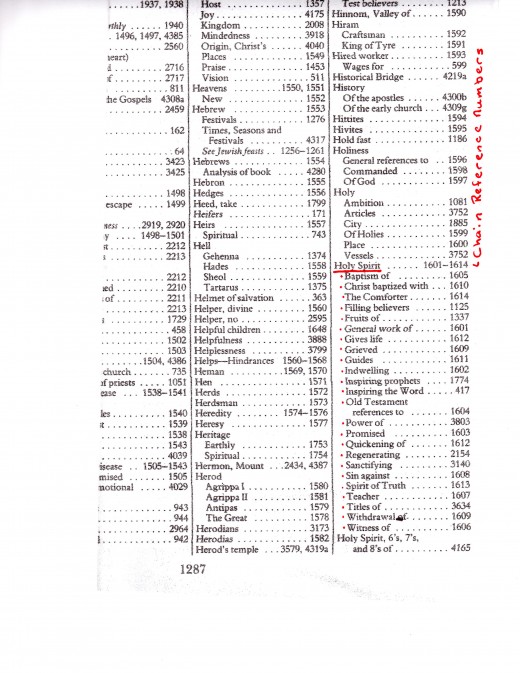
Chain Index
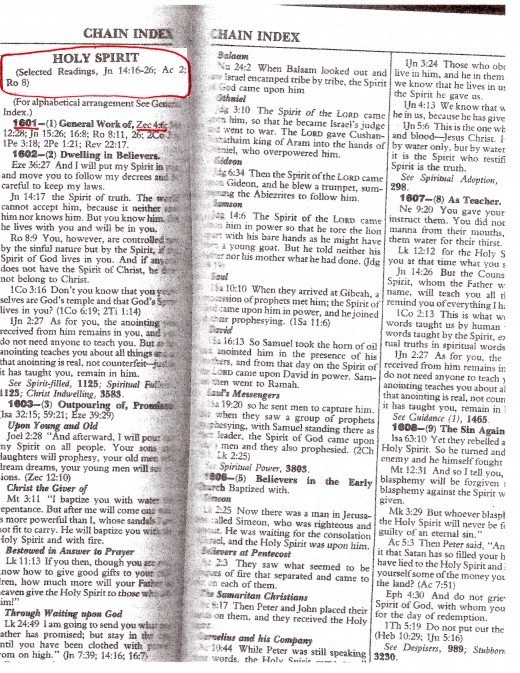
Zechariah 4:6
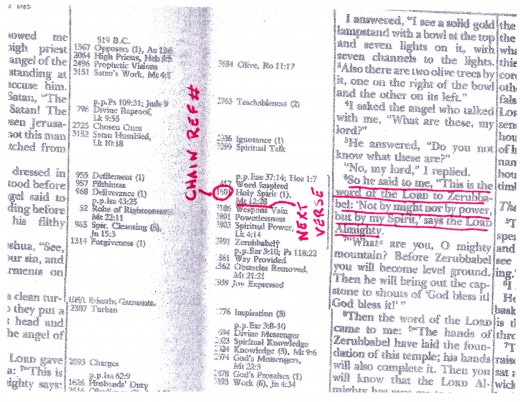
Resources for study
Tip #2 – Research your topic
Tool #2 – Thompson and Nave’s Bibles, the Library or Internet
Thompson’s Chain Reference Bible -My favorite and most often used tool for studying the Bible is the Thompson Chain Reference Bible. This is an excellent resource for an in-depth study of just about any topic. There are thousands of topics to choose from. Frank Charles Thompson has taken the time to compile a very extensive list of Bible topics in an organized numeral system. It assembles all the verses on a given topic into a chain. Here is how to use the Thompson Chain Reference Bible:
1. Choose your topic.
a. This can be anything from a person, a place, a concept, character trait, behavior trait, and more. A good example is the Holy Spirit.
2. Find your topic in the general index.
a. This is an alphabetical list of topics along with the corresponding chain reference number(s). Here you will also find a list of sub topics relating to your search and their chain reference numbers. The Holy Spirit is a large topic with multiple reference numbers. The general numbers are #1601 – 1614.
3. Next, look for that number range in the chain index.
a. The chain index is in both numerical and alphabetical order. If I am just looking for the general information, I can skip step 2 and find the Holy Spirit in the chain index by its place in the alphabet and this will bring me to its chain numbers 1601 – 1614.
b. Not all of the sub topics listed in the general index, can be found in this number range. For example, to read about the fruit of the Spirit, the general index would give me the number 1337. The fruits of the Spirit under the topic of Fruitfulness and the subtopic of Spiritual fruit.
c. #1601 gives a list of verses related to the general works of the Holy Spirit in the order they appear in the Bible
4. Look up the first verse in the list under the chain reference number and read.
a. Please read the surrounding verses to get an idea of the context and complete message before going on to step 5
b. Ask yourself questions about the passage, “What does this say, what does this mean, what does this mean to me?”
5. In the margin beside your target verse you will find your chain number and the next verse in the chain
6. Repeat step 4 until the final verse which will be marked with a cross
7. If you do not find what you are looking for, go back to the general or chain index and explore other subtopics
The Thompson Chain Reference Bible also has several other valuable study aids. It contains outlines of each book of the Bible, Character studies, Explanations of how the Bible came to be, Outlines of different histories, Temple diagrams, Prophesy lists, Detailed Maps, Cultural descriptions, a Concordance, suggested topics for bible study and prayer meetings, a section on Archaeological finds related to the Bible and more. The study possibilities within this valuable resource are almost endless.
Topical Bibles- There are several topical Bibles on the market today. The most well-known is Nave’s Topical Bible. With the intention of classifying everything in the Bible, Orville J. Nave references over 20,000 topics and subtopics in his work. More like a concordance than a Bible, Nave’s quotes complete scripture references for most of the verses under the topic headings. Naves can also be accessed online at www.biblestudytools.com/concordances/naves-topical-bible/.

The Internet/Library- The internet is a great place to get information on the history and culture surrounding the Bible. The web has opened up a whole new world of information and put it at our fingertips. However, we must remember that anyone can say anything they want and post it on the web. This means that there is just as much false as there is valuable information on the internet. It is important to be careful. Make sure the source of the article is reliable or that the content is well documented. It is a good practice to recognize opinions and take into account the perspective of the author when doing research on the internet. Take the time to read several articles on your subject and compare what they have in common and where they differ.
Bible Maps – Most Bibles include some maps of Israel during the different periods covered in the Bible. These can be very useful in understanding the land where Biblical events took place.
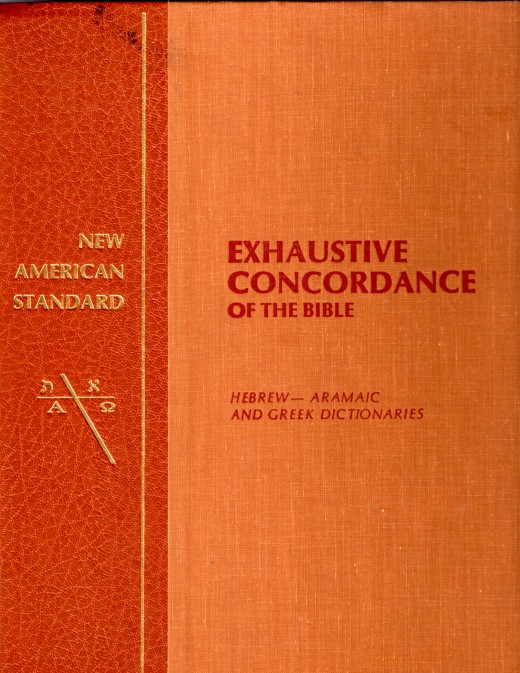
Concordance
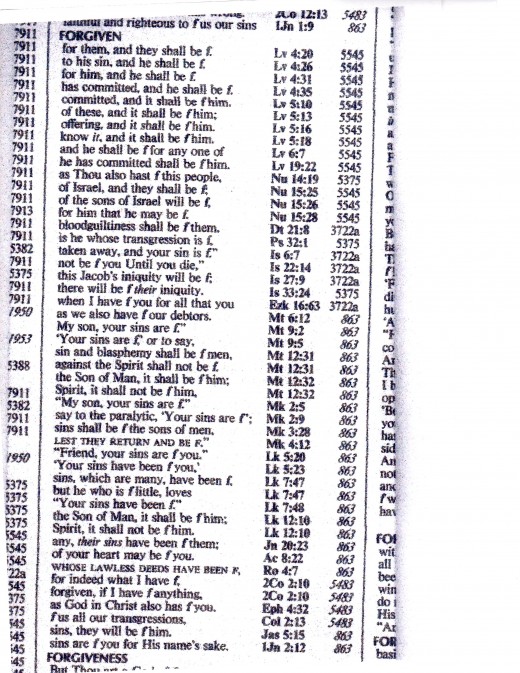
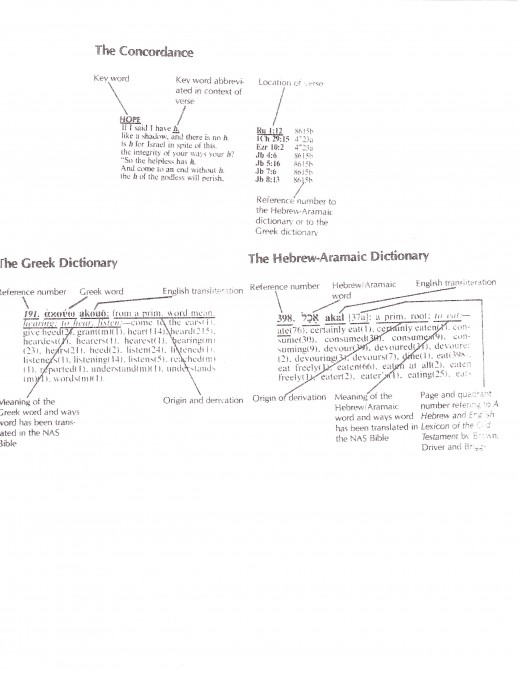
Tip #3 – Dig deeper with word studies
Tool #3 – Concordance and Dictionaries
Concordance – A concordance is an index of words used in the Bible. They tend to be specific to the different translations, listing the words and the verses where they are found. Most Bibles will have at least a small concordance included in a reference section. An extensive concordance such as Strong’s or the New American Standard Exhaustive Concordance will list every occurrence of the word you are looking up along with the original Greek, Aramaic or Hebrew word which the English word was translated from. Since words tend to change in use and meaning over time, this is an excellent tool in determining the original meanings of specific words in the Bible.
How to use the New American Standard Exhaustive Concordance
The New American Standard (NASB) Exhaustive Concordance is divided into 3 sections, the concordance, the Hebrew-Aramaic dictionary and the Greek dictionary.
1. Look up a word, such as forgiven, in the alphabetical listing.
You will find a list of every time the word ‘forgiven’ is used in the New American Standard Bible
2. Next to the scripture address, you will find a reference number. Notice there are three different Hebrew and two different Greek words which have been translated as “forgiven”.
a. The most common Hebrew word is #5545
b. The most common Greek word is #863
3. Find the reference number in the correct dictionary
a. Plain numbers are for the Hebrew-Aramaic dictionary
b. Italicized numbers direct you to the Greek dictionary
In the dictionary you will find the spelling of the word in both the original language and English along with its origin of derivation. You will then find its definition original definition and the other ways this word has been translated in the New American Standard Bible.
Strong’s Concordance is the best known concordance used in Bible studies. Here is an informative video on how to use Strong’s, both in book and online formats.
How to use Strongs Concordance in book form or online
Holman's Bible Dictionary
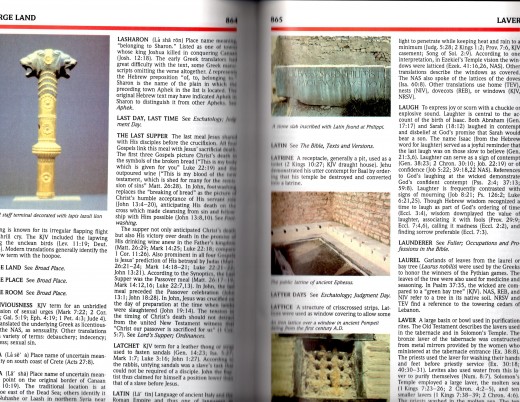
Bible Dictionary
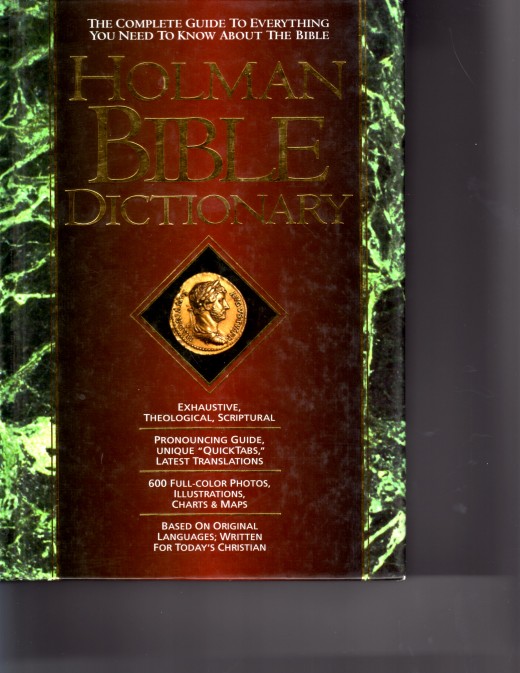
Dictionaries
Bible Dictionary – A good Bible dictionary will have detailed and in-depth definitions of just about every major word, topic or place found in the Bible. Colored pictures, time lines, diagrams and maps round out the information found in a good dictionary. In addition to definitions, a good Bible dictionary will also have extensive articles explaining every subject found in the Bible. In the Holman’s Bible Dictionary, topics are enhanced with photos of people demonstrating the subject, pictures of objects from archeological discoveries and museums, shots on location of places discussed, NASA generated maps and more. For each book of the Bible, an overview and outline is included. This is an excellent source for understanding the Bible and a complete guide to just about anything you want to know about our scriptures. Other top Bible Dictionaries include Easton’s Bible Dictionary and Vines Bible Dictionary.
Don’t forget Webster! Webster’s dictionary is a great tool for getting a good definition of our English words, especially the original dictionary from 1828. Noah Webster was a godly man who used the Bible extensively to define his words. Unfortunately, most of those definitions have been purged of any reference to God or the Bible in today’s editions.
Tip #4 – Read other people’s opinions
Tool #4 – Commentaries, Study Bibles and Bible study books
Commentaries - If you have done your research and are still unsure of the meaning behind a certain passage of scripture, you can take advantage of someone else’s research and knowledge by reading a commentary. A commentary is a book or article written by someone who has studied the Bible and is sharing the results of their research and their conclusions with you. It is important to realize that commentaries contain a lot of personal opinion which you have the freedom to agree or disagree with. It is always a good idea to read multiple commentaries on a certain scripture to get a look at several different perspectives. To read more on commentaries, please read my hub, “How to use a commentary, why did Nichodemus meet Jesus at night”. To read my own commentary on the book of John, please begin with my hub, “Who was the apostle John?”
Study Bibles -There are several Study Bibles on the market today. A study Bible has the advantage of having a commentary along with the scriptures. It’s a good way to get historical facts, cultural insights, explanations and application tips at your fingertips while you are reading your bible. Keep in mind the importance of discerning between fact and opinion.
Bible Study Books –This is probably the most common tool used among Christians to study the Bible. It helps the reader dig deeper into the scriptures with valuable insight and questions designed to inspire personal thought and reflection. There are many different kinds of bible study books. Some of them focus on a particular book of the Bible and take you through it verse by verse or chapter by chapter. The Lifechange series is such a study. It is primarily questions with short historical and cultural facts. There is very little commentary, but a lot of guides to help you find the truth for yourself. Warren Wiersbe’s “Be” series is another such study. It is mostly commentary with questions to answer at the end of each chapter. Most bible study books are topic related. The study will take you through what the Bible has to say on a given topic and will have questions to help you think through what you are reading. These are also mostly commentary, with the author giving his or her opinion and life experience on the chosen subject. When reading bible study books, it is important to make sure the author is using the Bible in context to back up their statements, beliefs and opinions. Remember, the best book about what the Bible has to say, is the Bible itself.





